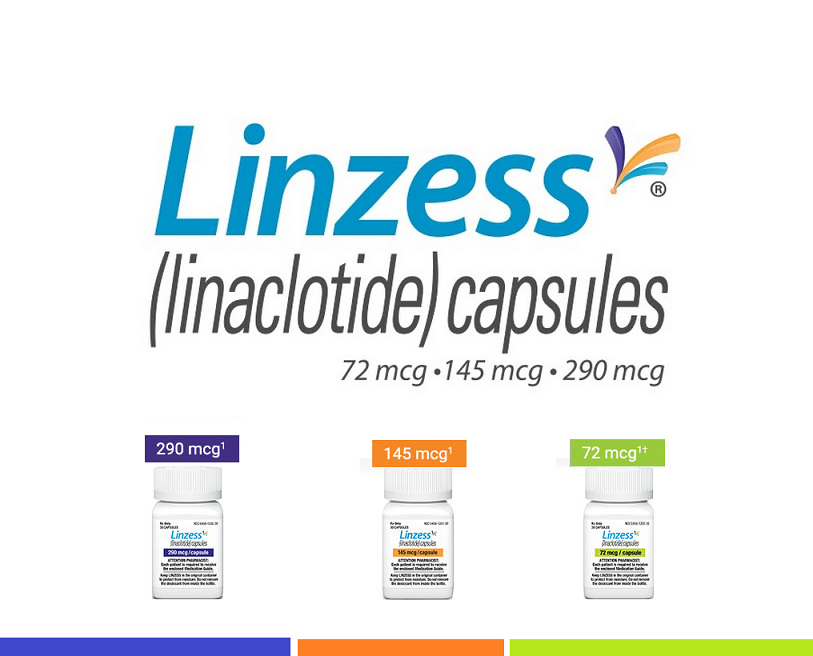Linzess uses and MOA to relieve constipation is discussed here in detail. Linzess is the brand name of Linaclotide. It is distributed and marketed by Allergan as oral capsules in three different capsule strengths:
- 72 mcg oral capsules
- 145 mcg capsules
- 290 mcg oral capsules.
Linzess Uses (Linaclotide uses):
Linzess is used to treat:
Chronic idiopathic constipation:
- Chronic idiopathic constipation is a condition that is not caused by any underlying anatomical or organic cause. It is not caused by any hormonal disorder, electrolyte abnormalities, or other medical cause. The condition is characterized by difficulty passing stools and often associated with discomfort and reduced frequency of defecation.
Irritable Bowel Syndrome with predominant constipation:
- IBS is again a functional disorder. It is characterized by abdominal pain that is relieved by passing stools. It is usually associated with a change in stool consistency and frequency. IBS-C is IBS with predominant symptoms of constipation. There is no underlying anatomical, hormonal, or metabolic causes that could cause constipation.

Linzess MOA (Mechanism of action of Linaclotide):
The three main mechanisms by which Linaclotide (Linzess) acts to relieve chronic idiopathic constipation and IBS-C (irritable bowel syndrome with predominant constipation) are:
- Increasing intestinal fluid content
- Increasing the intestinal motility and transit, and
- Relieving abdominal pain.
How Linzess (linaclotide) increase the intestinal fluid content?
Linaclotide is a guanylate cyclase-C agonist. It is structurally related to the endogenous human guanylin and uroguanylin. Linzess binds to the guanylate cyclase C (GC-C) receptors present in the luminal surface of the intestine.
After binding to GC-C receptors, it causes an increase in the cyclic guanosine
monophosphate (cGMP) levels both inside and outside the cells. An increase in the cGMP levels causes the activation of CFTR ion channels (cystic fibrosis transmembrane conductance regulator).
Once the CFTR ion channels are activated, bicarbonate and chloride are excreted out of the cells into the intestinal lumen. Thus, Linzess causes an increase in the intestinal fluid content rich in bicarbonate and chloride ions.
Lubiprostone (Amitiza) is a chloride channel activator that also increases intestinal fluid content.
How Linzess (linaclotide) increase intestinal motility and intestinal transit?
Linaclotide increases the fluid content in the intestinal lumen. An increase in the fluid content especially fluid that is rich in chloride and bicarbonate activates the peristaltic activity of the smooth muscles of the intestine, thereby, increasing the gut transit.
Linzess may also have a direct effect on the smooth muscles of the intestine, however, data in this regard is limited.
How Linzess relieves abdominal pain?
It was studied in rodents that linaclotide has nociceptive i.e. pain-relieving properties. It relieves the visceral pain associated with IBS by inhibiting the contraction of abdominal muscles and increasing the pain threshold of the pain-sensing nerves in the intestine.
The pain-relieving effect is primarily mediated by extracellular cyclic guanosine
monophosphate (cGMP). The reduction in pain could also be a result of relief from long-standing constipation that is usually associated with anxiety.
In Summary:
Linaclotide is used to relieve chronic idiopathic constipation and IBS-C. It acts by increasing the levels of intracellular and extracellular cGMP, resulting in the intestinal secretion of fluid, increasing the motility of the gut, and relieving visceral pain.
Read: Linaclotide, Plecanatide (Trulance), & Lubiprostone(Amitiza) dosages, side effects, and MOA
